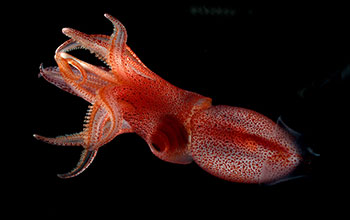Multimedia Gallery
Cockeyed squid (Histioteuthis heteropsis)
The cockeyed squid Histioteuthis heteropsis, also known as the "strawberry" squid for its pink color and smattering of seed-like photophores, has evolved a mismatched set of eyes: one large eye (pictured) for seeing the shadows of fellow sea creatures above, and one small eye for spotting bioluminescent flashes below.
More about this image
Evolution has given deep-sea-dwelling creatures strange features to survivie their cold, dark habitat, everything from eyes the size of basketballs to appendages that blink and glow. The squid Histioteuthis heteropsis is no exception, with one normal eye and one giant, bulging, yellow eye--hence the name "cockeyed" squid.
Biologist Kate Thomas of Duke University has studied more than 150 undersea videos of the cockeyed squid--collected by the Monterey Bay Aquarium Research Institute--and has gathered the first behavioral evidence that the squids’ lopsided eyes evolved to spot two very different sources of light available in the deep sea.
These observations, combined with visual simulations, indicate that the large eye is specifically adapted for gazing upwards, searching for shadows of fellow sea creatures against the rapidly fading sunlight, while the small eye is adapted for gazing downwards, scanning deeper, darker water for flashes of bioluminescence.
"The deep sea is an amazing natural laboratory for eye design because the kinds of eyes you need to see bioluminescence are different from the kinds of eyes you need to see the basic ambient light," said Sönke Johnsen, a professor of biology at Duke and senior author on the study. "In the case of the Histioteuthis, this cockeyed squid, they chose one eye for each."
Cockeyed squid are also called "strawberry" squid due to their bright pink body and smattering of seed-shaped photophores--organs that produce light. Photophores can be fine-tuned to match light from above, allowing the cock-eyed squid to become nearly invisible, or may be used to attract mates and curious prey. Histioteuthis lives in a region of the ocean known as the mesopelagic--or "twilight"--zone, 200 to 1000 meters below the surface.
The meager light that does reach these depths is extremely dim, a monochromatic blue, and travels straight down from above. Often, the bioluminescent flashes of other sea creatures--which could signal danger or potential prey--are brighter than the ambient sunlight.
This research was supported in part by a National Science Foundation Graduate Research Fellowship (grant DGE 11-06401).
To learn more about this research, see the NSF News From the Field story Mismatched eyes help squid survive ocean's twilight zone. (Date image taken: August 2015; date originally posted to NSF Multimedia Gallery: March 24, 2017)
Credit: Kate Thomas, Duke University
See other images like this on your iPhone or iPad download NSF Science Zone on the Apple App Store.
Images and other media in the National Science Foundation Multimedia Gallery are available for use in print and electronic material by NSF employees, members of the media, university staff, teachers and the general public. All media in the gallery are intended for personal, educational and nonprofit/non-commercial use only.
Images credited to the National Science Foundation, a federal agency, are in the public domain. The images were created by employees of the United States Government as part of their official duties or prepared by contractors as "works for hire" for NSF. You may freely use NSF-credited images and, at your discretion, credit NSF with a "Courtesy: National Science Foundation" notation.
Additional information about general usage can be found in Conditions.
Also Available:
Download the high-resolution JPG version of the image. (3.0 MB)
Use your mouse to right-click (Mac users may need to Ctrl-click) the link above and choose the option that will save the file or target to your computer.



